Introduction
In 2010 when Apple released its iPad, consumers waited in line for several hours in order to acquire the new sleek techno-gadget from Apple. This unique behavior among Apple consumers makes a lot of sense to Apple, marketing firms, and psychologists, who are all interested in the reasons that drive Apple’s brand and why consumers have such overwhelming affection for Apple techno-gadgets all over the world (Blythe, 2008; Kurtz, 2008).
This research investigates student consumer psychology of Apple products in the United Kingdom.
Research Purpose
The purpose of this research is to investigate student consumer psychology of Apple products in the United Kingdom. Apple has developed products for students and teachers. As a result, students have made Apple products their first choice (Slivka, 2010; Marczewski, 2011). Therefore, it would be interesting to understand how student consumers’ psychology affects their purchasing behavior of Apple products.
Research Objectives
This project aims to investigate student consumer psychology of Apple products in the United Kingdom. The specific objectives of the research include the following:
- To investigate student consumer psychology when purchasing Apple products in the UK
- To explore the relevance of features of Apple products in influencing the UK student purchasing decision
Research Questions
- Do Apple products influence purchasing decisions among students in the UK?
- Do features of Apple products influence purchasing behavior among students in the UK?
Relevance of the research
Apple has developed features and applications for students. This research seeks to improve understanding of students’ behaviors towards Apple products, but specifically, the extent to which student consumers’ decision-making about Apple products can offer required insights in marketing for high technology firms.
Guiding Theory
This research uses the consumer behavior model to investigate student consumer psychology of Apple products in the UK.
Literature Review
Apple enjoys pure loyalty among its consumers, who have become brand-centric fan groups. As a result, Apple has developed a brand community among students all over the world. The Apple brand community has grown out of consumers’ own fanaticism for the product rather than sly marketing efforts. In some cases, a brand community may arise out of necessity, be a part of a group, and show that the users of a particular product have understood the essence of their brand (Sharma, 2006; George, 2010).
Apple has learned to keep its brand community busy with new features and products. This can fuel any form of fanaticism among users. This is usually the case with any brand, and users may transform such brands into lifestyle products. According to consumer psychology studies, Apple has created a brand that is more than just a set of attributes but a core part of a consumer, i.e., the Apple brand defines its consumers by symbolically reflecting their lifestyle.
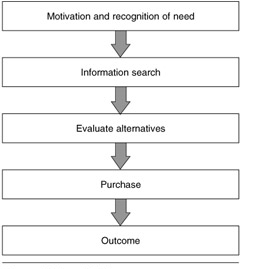
Hoyer and colleagues note that consumer behavior has four core areas (Hoyer, Macinnis, and Dasgupta, 2008). These include the following:
- Psychological core or internal influences
- Consumer culture or external influences
- The process of making decisions
- Consumer behavior outcomes
Psychological Core or Internal Influences
Perception of consumers affect their behaviors towards certain products and services (Solomon, 2006; Khan, 2007). Experiential senses and other senses usually affect the manner in which consumers perceive products. We have selective attention in which product marketers must “strive in order to attract the attention of consumers” (Young & Pogaso, 2008). Consumers also engage in selective distortion of information in order to suit their own interests. In addition, there is also selective retention. This is the tendency of consumers to retain only data they think are useful (Young & Pogaso, 2008).
iBummed notes several sensory factors influence the purchase decision of Apple products (iPod) (iBummed, 2009). Users claim that such products are “innovative with a widescreen and simple design” (iBummed, 2009). Moreover, Apple products are user-friendly. The product has high-quality parts and materials, and it appeals to the sense of touch. These products reflect the self-image of their user. They usually reflect the hedonic habits of the consumers.
Hoyer and fellow authors consider consumer attitude as “the overall expression of how much consumers may like or dislike an object, product, or service from on the consumers’ personal experience” (Hoyer et al., 2008). Consumers have an affective attitude towards certain products. Apple has been able to manipulate consumers’ affective attitudes by including emotional appeals in their products.
Consumers also have cognitive attitudes. Consumers generate a cognitive attitude with regard to real or imagined factors, which are usually value-driven. In most cases, consumers tend to draw analogies or introduce aspects of social or environmental factors when engaged in cognitive attitude (Chisnall, 1995).
behavioral attitudes among consumers are likely to have “a significant impact on consumers when they have a high level of cognitive engagement and involve extensive thought processes, which eventually lead to the purchase of the product” (Hoyer et al., 2008). Thus, Apple customers believe that the values of their preferred products are in utilitarian functions. Apple products provide such value to their users. The product can satisfy their immediate needs, enhance group affiliation and positive image among the community of users.
Consumers also apply learning and memory processes when making decisions to purchase a product. Learning occurs due to experiences with products. Young and Pogaso note that learning depends on “impulses, motivation, stimuli, cues, responses, and motivation” (Young & Pogaso, 2008). Therefore, consumers experience the drive, cues, and reinforcement during the decision-making process. These processes and actions intensify when consumers’ expectations match the product features. iBummed notes that positive reinforcement is responsible for loyalty that is observable among Apple consumers. Students believe that Apple products are trendy, slick, and attractive. As a result, the product shall reinforce their self-images. Moreover, most successful executives, athletes, and other role models use Apple products. This serves as observational learning for students, who wish to imitate their role models. In fact, iBummed notes that Apple iPod has a strong hold on consumers to the extent that many users associate portable music with iPod (iBummed, 2009). Besides, Apple has developed features that keep its consumers fully engaged with products. Therefore, Apple products are high-involvement products that students need to have.
Motivation occurs because of a need and the drive to satisfy that need. We have several needs that we may take an initiative to fulfill. First, we have biogenic needs, which are “physiological in nature and are mainly thirst and hunger” (Young and Pogaso, 2008). Second, we also have psychogenic needs, which result from the need for recognition and self-esteem. Psychogenic needs may occur with biogenic needs together.
The motivations to purchase Apple products among students are to “facilitate learning, store huge amount of information, and enhance status symbol” (iBummed, 2009). Apple has developed several applications for students and teachers (Apple, 2013). These features have been the main primary drivers for student consumers of Apple products. Moreover, students also get pressure from their peers to purchase cool gadgets from Apple, and they must fulfill this pressure by purchasing such products. According to Tom Anderson of Anderson Analytics, “They (students) have huge impact on what their parents buy, and then they have their own money, more than any other generation before them, and of course they are the consumers of tomorrow” (Anderson Analytics, 2007). This has led to the purchase of Apple products among the older generation too.
The expectancy theory can indicate the level of motivational effects among Apple users when the products meet their expectations. Apple products meet the hedonistic needs of students through their exciting, friendly, and several applications, which are simple to use. Based on Maslow’s theory of need hierarchy, students may purchase Apple products in order to meet the need of affiliation and achievement because these products are luxurious, trendy, and belong to technologically novice users. Students are a part of this brand community whether they are online or offline with Apple products because they can share experiences and knowledge through Apple products.
Consumer Culture or External Influences
Young and Pogaso describe culture as “the communal aggregation and convergence of the country’s philosophy, beliefs, traditions, values, attitudes, aspirations, and practices which have evolved since its inception“(Young and Pogaso, 2008, p. 78). Within a culture, we also have sub-cultures. However, social class influences the use of the purchase of Apple products. Users of Apple products are mainly middle and upper classes with a certain level of affluence. They purchase premium products and unique features the gadget can provide.
Apple product consumers are mainly people aged between 18 and 24 years, majorities of whom are students. They exhibit high levels of consumption. As age increases, the usages of Apple products decline. Students have a high degree of involvement with their Apple gadgets. For instance, at Choate, a consumer of Apple products claims, “My whole career has been shaped by Apple products” (Marczewski, 2011). This belief shows high students and teachers have adopted Apple iPhones and Mac in colleges. Students and teachers believe that Apple computers make their work simply because the features are easy to use and find. Apple developed products for students who are always on the move and need gadgets to reinforce their group affiliation. Apple satisfied consumers’ social needs.
Students also tend to spend on Apple products. Generation Y is the main consumer of Apple products. Anderson observes that this group of consumers has high disposable income than the previous generation. These consumers dictate what their parents buy for them. For instance, Mr. Speyer of Choate claims that “Parents see their children’s success with Apple products, which has also convinced them to switch from PC to Mac” (Marczewski, 2011). Students may also use their savings to purchase Apple products because of the brand perception.
It is Lifestyles
“Almost the entire Choate population owns at least one Apple product be it a Mac computer or an iPod” (Marczewski, 2011). In recent times, about “ninety percent of students reported to Choate with Mac computers” (Marczewski, 2011). Five years ago, students who owned Apple Mac were barely 50 percent, whereas the number was below ten percent in the past seven years. This dramatic ownership and use of Apple products among students only show love for Apple gadgets. Most users believe that Apple products are aesthetic, attractive, and user-friendly.
Apple products have multiple usages and can fit several occasions. For instance, iPod can fit both social and professional environments. Multiple applications in a single gadget allow users to perform several tasks with ease. Besides, the sleek designs provide the convenience that most users prefer.
Rachael Rettner looks at obsession with Apple products as a cult-like phenomenon. She notes that there is “no doubt that a strong sense of devotion to the brand is there” (Rettner, 2010). According to Rettner, the Apple brand goes beyond and presents a sense of self’ among users. The brand taps the lifestyle of its users. Kahle of the University of Oregon concurs, “Apple, I think has done a good job of having its brand image connect to the core values and core lifestyle aspects of people” (Rettner, 2010). In other words, the Apple brand aims to reinforce a sense of freedom and independence, especially among students who value such lifestyles. Thus, the brand did not aim to turn users to slaves of technology.
It is also critical to note that Apple users and fans exhibit specific attitudes. For instance, Florian Brunbauer (a designer and seller of iPhone and iPad apps) claims, “I would really consider people who use it as open-minded to technology and liberal and everything” (Rettner, 2010).
Such claims among users of Apple products show how the brand reinforces personality and the concept of self-image. Most of these users purchase Apple products because they are trendy, innovative, attractive, and passionate. iBummed refers to the personality of Apple users as “individualistic and social climber” (iBummed, 2009).
Social factors also play a significant role in shaping consumer psychology (Assael, 2005; Hansen, 2008). Students belong to certain social groups. These are informal and highly interactive groups, which have a significant influence on purchasing behaviors among their members. Social groups have served as sources of aspiration to purchase a product.
Apple products have established “a degree of affiliation through positive reinforcement of consumers’ social image” (Lantos, 2008). In fact, most users of Apple products seek to serve their self-centered needs. For instance, Andy Vuong observed the first consumers who purchase iPhone 5 noted that “We’re very social animals and when we see someone else doing something, we automatically infer that it might be a good thing to do” (Vuong, 2012).
The Process of Making Decisions
Consumers base their decision-making processes on experiential results. Consumers engage a high level of cognition when making a decision to purchase expensive Apple products. In fact, many users engage in thorough research, both online and physical consultation with families, friends, and colleagues. The aim is to ensure that the model meets the specific social and status needs of the user. However, this may be different for Apple products because consumers believe that Apple is the industry leader and offers the best product so far. Therefore, making a decision to buy products from Apple is simple. Phillip Graves describes his experience as follows, “I enjoy observing my own consumer decision-making and, although I know that much of the action takes place outside my conscious awareness, my work on the consumer unconscious mind gives me a dual perspective for my own consumer behavior” (Graves, 2011).
Consumer behavior Outcomes
In most cases, many Apple consumers have expressed great satisfaction with the product performance. As a result, there is a significant number of repeat purchases and brand promotions among users. In fact, Apple users are anxious to get the latest products from the company. Many users also own several products from Apple. Thus, Apple’s products meet the marketing strategies and behavioral patterns of most consumers (Kotler et al., 2005).
Research Methodology
This part provides the method of collecting the necessary data to meet research objectives. according to Howe and Eisenhardt, “methodology must be judged by how well it informs research purposes, more than how well it matches a set of conventions” (Howe and Eisenhardt, 1990) in the final analysis. Therefore, the aim of the research methodology is to collect data that respond to the research issue, present coherent background assumptions, and ensure that the methods used work well to account for the credibility of the results.
Good research should provide a theoretical frame, scientific design, measurement methods that show reliability and validity, apply appropriate statistical methods of analysis, and generalize findings so that fellow researchers can borrow and learn from the results. Therefore, guiding theory, clear objectives, research methods, confidence in conclusions, and clear implications are useful and ensure that a study meets scientific standards.
Research method
There are a number of research methods for data collection in a study. This research relied on both qualitative and quantitative methods to collect the necessary information for the study. The qualitative study accounted for non-numerical factors of student consumers’ psychology of Apple productions in the UK. Therefore, this approach provided descriptive and interpretative data for the study. Conversely, the quantitative study addressed numerical data from quantitative research aspects (Trochim, 2006). Moreover, it allowed the researchers to provide high levels of confidence in inferences.
The researcher adopted a mixed-method study in order to achieve the following advantages. First, the researcher wanted to achieve the research validity through triangulation. Triangulation involves the verification of study findings. For instance, the researcher used both qualitative and quantitative methods in order to assess the consumer psychology of students in the UK who used Apple products. Second, the researcher wanted to enhance the research validity and interpretability. This served as a method of complementing the other method, but with a different focus on other aspects of the study. For instance, in this study, the research measured perceptions of student consumers in the UK by using qualitative surveys and influences of such consumer perceptions on other students who used or had Apple products by applying quantitative methods.
Third, mixed-method allowed the researcher to use results from the two methods in order to develop and inform the other approach. For example, quantitative survey results informed the qualitative design in which the research sought to understand the in-depth perceptions of students about Apple products. Fourth, the mixed study approach has proved useful in providing the necessary depth in research. The researcher was able to gain fresh insights during the study because of using the quantitative method, which allowed him to adjust the study in order to reflect consumer psychology. Such insights are difficult to plan in the research design before the study commences because they emerge in the field. Finally, the mixed-method approach provided an opportunity for the researcher to expand the scope of the study. For instance, the researcher used the qualitative method as a tool for assessing decision-making processes among consumers, as well as the quantitative method in order to assess the outcomes of consumer behaviors.
Therefore, this method offered an opportunity for the researcher to shift triangulation and expand the scope of the study (Trochim, 2006).
This was an exploratory study with a mixed-method approach. The study explored student psychology about Apple products in the UK. The research focused on two objectives about consumer behavior and product features and influences on consumers. A total of 75 students in the UK college responded to the questions.
The researcher used closed-ended questions, as well as open-ended questions in order to gain insight into student psychology as consumers of Apple products.
Target of research
This research specifically targeted the UK students, who had, had used, or purchased Apple products.
Data collection method
The study used different methods of data collection methods. Survey questionnaires provided the study with the advantage of engaging respondents in a face-to-face survey to gather information from student consumers of Apple products. The aim of the interview was to get in-depth data about student consumer psychology of Apple products.
The researcher ensured the validity of research instruments by ensuring that research instruments measured what they aimed to measure. These instruments were specific to Apple student consumers in the UK.
This approach was vulnerable to respondents’ bias. At the same time, some of the questions sounded suggestive. The social desirability bias of the respondents must have influenced the study outcomes because the study sought to understand the behaviors and attitudes, which were related to Apple products. The problem with behaviors and attitudes that the researcher sought to assess where socially desirable, such as social status, affluence, freedom, open-mindedness, and others. As a result, student respondents were inclined to present the best results in order to relate with the status attached to the Apple brand. However, the research attempted to mitigate this bias by designing research questions to control the bias.
This research was a self-report. A number of studies normally rely on results, which are obtained through self-report. For instance, students expressed their experiences with Apple products in their responses. Such self-reports provided in-depth experiences of consumers. However, they posed a significant threat to the study. The respondents may have responded to questions based on their social desirability. In other words, the responses may not reflect the actual behaviors or experiences of consumers, or results may not show the correct processes of decision-making when purchasing Apple products. Still, there could have been memory or inaccurate bias, which could have affected the responses.
Sampling
The research relied on random sampling. The sample was adequate to allow the researcher to generalize the results to other students in other locations within the UK. The researcher used both “quantitative and qualitative approaches in the study” (Bazeley, 2002). A large sample allowed the researcher to conduct a hermeneutic analysis of collected data (Bazeley, 2002). Bazeley notes that such analyses are possible because of computer programs that can analyze data from both qualitative and quantitative respondents.
Random sampling allowed the researcher to collect data from the representatives of the samples. All samples had equal chances of participating in the survey. This method also provided the researcher with the ease of finding respondents. Moreover, it was fair regarding the selection of research participants because of an equal opportunity of representation. This study was an unbiased random selection of the study samples. Therefore, it provided good opportunities for the researcher to draw a generalized conclusion from the study. The aim of the researcher was to be able to draw a conclusion that reflected the study subjects (Wolcott, 1994).
One major drawback of this method was the inability of the researcher to obtain a list of all students who were potential participants in the study. Random sampling must have a complete and updated list of potential participants. The challenge was getting an updated list of the large student population.
Sample size
The researcher gathered data from students only. The sample size was 75 students from the UK in which the researcher selected each participant independently of the other. It was the belief of the researcher that this sample size was representative of student consumer psychology among Apple product users.
Data Analysis
The researcher cleaned data after collection by ensuring that all responses were corresponding to the right questions. All data from qualitative sections were organized into themes consumer psychology based on experiences with Apple products. In qualitative data, the researcher coded common themes and organized quantitative data into numeric (Miles and Huberman, 1994).
The researcher used SPSS version 17 for data analysis (Pallant, 2005). This provided a good chance for the researcher to analyze qualitative data after coding. The researcher relied on descriptive statistics for quantitative data and used an analytical framework for qualitative data (Wolcott, 1994).
This study being a mixed-method, the researcher presented results by using both descriptive statistics and analysis of qualitative in relevant themes.
The researcher ensured the credibility of the information gathered for analysis. The respondents’ bias could have affected the outcome of the study (Patton, 2002). This process ensured the internal validity of the research. Still, the researcher ensured external validity of the research by observing transferability i.e., ensuring “generalization and transfer of the results to other settings” (Patton, 2002).
The researcher presented findings from this study through graphs and narrative format.
Ethical issues
The researcher observed all guidelines of ethics in research as Beauchamp and Childress indicated (Beauchamp and Childress, 2001). The University provided ethical guidelines for this study. In addition, the researcher gained the oral consent of all research participants before the start of the survey (Pimple, 2006). Overall, the researcher:
- Respected autonomy of choices of respondents
- Confidentiality
- Protection of all participants
- No personal data were gathered in the study
- Research participants were free to withdraw from the study at any time
- The researcher observed professional code of ethics as the University provided
- The participants understood the purpose of the study
Study Findings
The total number of research respondents was 75. Most students who owned Apple products were aged between 18 and 24 years (61.3 percent) while the other category was 25 years and above. Thus, the researcher focused on young consumers, who were mainly students. All respondents were students, and this number was well representative of the student population. Figure 3 shows that 60 percent of the students who participated in this survey were male while the rest 40 percent were female students.

All participants surveyed owned at least one Apple product. Majorities, who have owned Apple products for a longer period than the rest, were aged 25 years and above (fig. 2). However, there was a change in ownership as students aged between 18 and 24 years owned Apple products before joining college.


These students also owned other brands apart from Apple products (fig. 6). However, the majority planned to purchase Apple in the future (fig. 7). The number of students who use Apple products has increased, whereas those who use other brands have declined. HP/Compaq was the main rival of Apple among student consumers in the UK. This shows that students tend to identify themselves with known brands in the market.
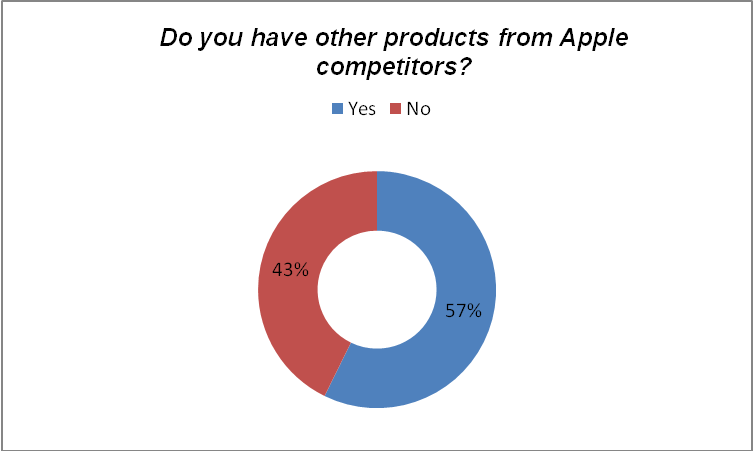
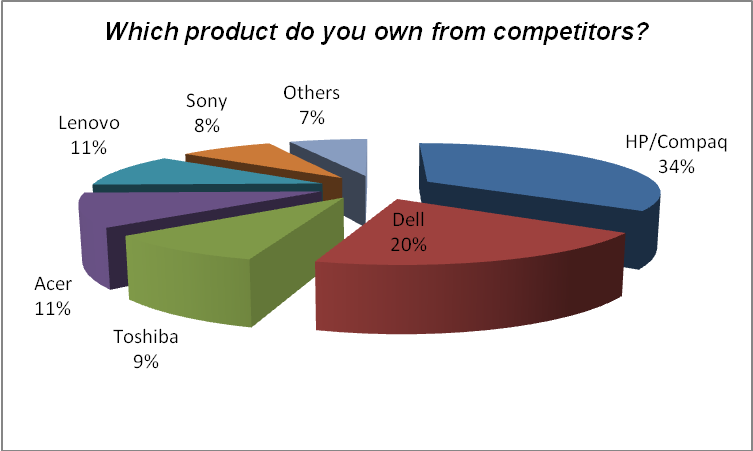
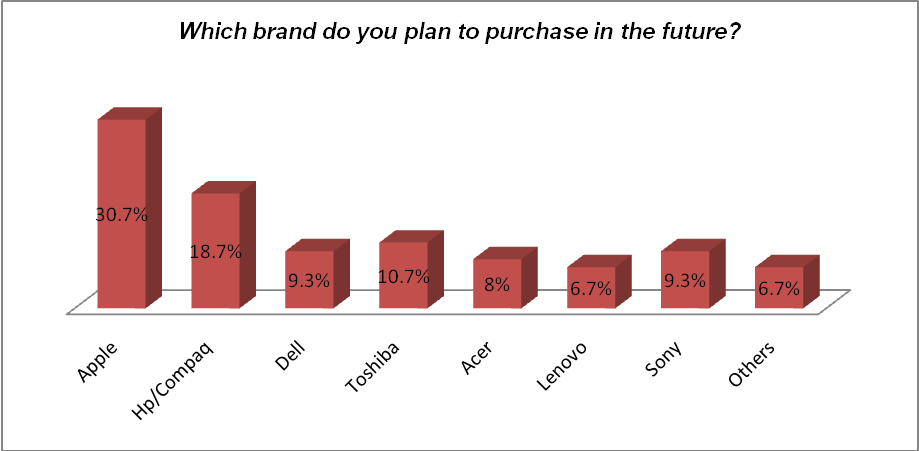
Do Apple products affect student consumers purchasing decisions in the UK?
All students interviewed admitted that Apple product features were the most influencing factors in their purchasing decisions. Many students believed that Apple products made their lives simple while on the move because of portability. Many students also considered the prices of the products to be important (fig. 8).

Students consider student-specific features in Apple products. Figure 9 shows that Apple has gained a greater market share among students because it provides specific features for students and thousands of apps for learning. Many competitors do not have such features.
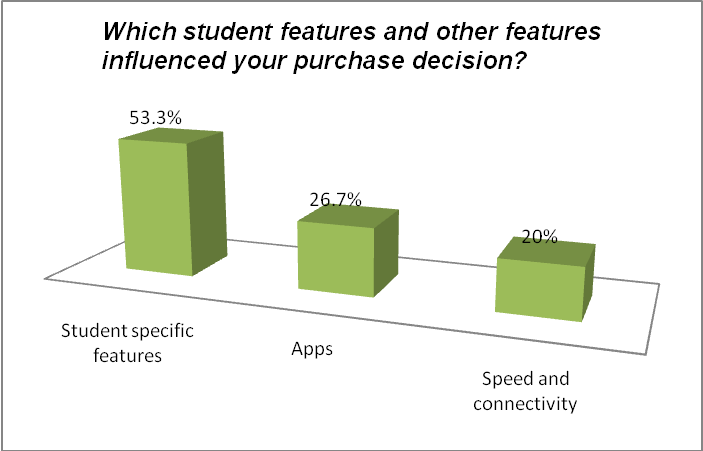
With specific products, some students have noted that the iPhone 5 is lighter, thinner, and faster than the previous versions. It also has a wide screen with high-speed network connectivity. Thus, they feel that iPhone 5 is like a computer in a pocket.
Are the UK students obsessed with Apple products?
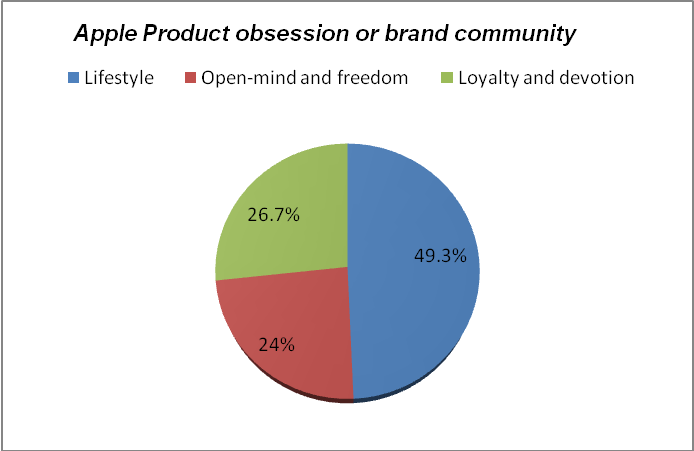
Most students consider Apple products as a part of their lifestyles. At the same time, such students associate Apple products with open mind, freedom, and brand devotion.
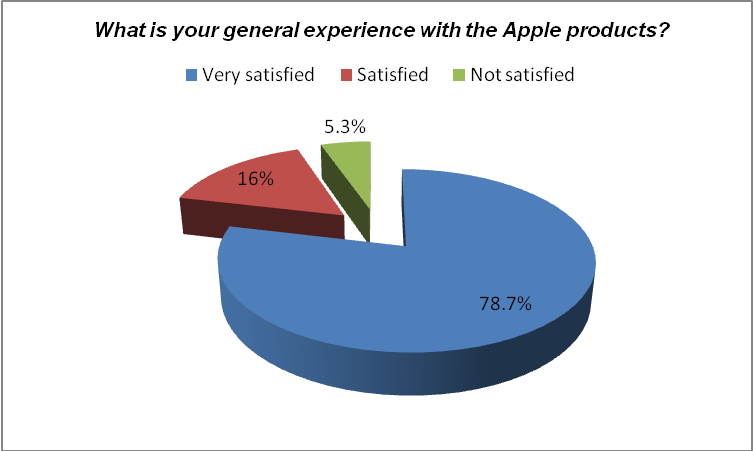
Discussion of the Results
Many students who own Apple products are mainly aged between 18 and 24 years. The other group of student consumers were in aged 25 years and above. This result confirms other findings in the use of Apple products among students. Moreover, there is no doubt that specific Apple product features had significant impacts of their purchase decision-making processes.
Anderson Analytics’ study noted that this generation of students has high disposable income than other previous generations (Anderson Analytics, 2007). Therefore, purchasing premium Apple products does not have a significant impact on their purchase decisions. In fact, many students plan to purchase Apple products in the future.
The study established a strong devotion to Apple brands. The brand enjoys a strange sense of devotion among students. At the center of this devotion is the idea of ‘self’. Most students note that Apple products enhance their self-image among peers, and this is what is truly important within the brand community. Therefore, Apple products are a part of students’ lifestyles.
Apple products are generally appealing to students. They know Apple for innovation, sleek designs, and products, which students find appealing. Moreover, students also claim that Apple products are user-friendly because applications are easy to find. Still, they also like compatibility and several ranges of products from Apple, which complement one another. Overall, student-specific features have attracted the attention of most when making a purchase decision. In fact, all students note that Apple feature have transformed their learning experiences.
Recommendation
Marketers must exploit this information by highlighting specific features, which appeal to students in their marketing campaigns. Most prominent brands in the smart technologies have increased. Therefore, Apple must enhance their marketing strategies in order to continue with the noticed growth among student consumers. It gadgets must address the specific needs of students, aesthetic values, social status, social image, lifestyles, and emotional appeal of students.
Conclusion
This study explored the student consumer psychology of Apple products in the United Kingdom. The study noted that students considered Apple products as parts of their lifestyles, and there was “a strong sense of devotion to the Apple brands” (Rettner, 2010) as Rettner showed in her findings.
The study presents strong points for marketing purposes. The researcher notes that Apple should engage students in their advertisements because they are potential customers than other users within their age bracket. However, marketing strategies must simplify these features and show their real impacts on the lives of their consumers.
Consumer behavior outcomes with regard to the purchase of Apple products are generally positive experiences, which have reinforced their belief in Apple products. As a result, these students have increased their brand devotion and often purchase subsequent versions because some of them have more than one product from Apple. Therefore, we can conclude that Apple marketing strategies have matched the behavioral tendencies of student consumers. Therefore, by showing how Apple the products enhance lives of students, Apple has also created a formidable brand personality and characteristics among student consumers.
This study focused on student consumer psychology with regard to Apple products, but it did not explore the obsession or cult-like behaviors within the Apple brand community. However, future studies should explore the extent of obsessions with Apple products among students.
Reference List
Anderson Analytics. (2007). Apple tops brand survey, Web.
Apple. (2013). Why Mac for College, Web.
Assael, H 2005, Consumer Behavior: A Strategic Approach, Dreamtech Press, New Delhi.
Bazeley, P 2002, Computerized data analysis for mixed methods research, Sage, Thousand Oaks, CA.
Beauchamp, T & Childress, F 2001, Principles of biomedical ethics, Oxford University Press, New York, NY.
Blythe, J 2008, Consumer behavior, Cengage Learning EMEA, Hampshire.
Chisnall, P 1995, Consumer behavior, McGraw-Hill, New York.
George, S 2010, Consumer behavior: For Notebook Computers, VDM Publishing, Saarbrücken.
Graves, P 2011, Consumer behavior: Dell Finally Convert me to Apple, Web.
Hansen, H 2008, Consumer behavior: A Global Outlook, Prentice Hall, New York.
Howe, R, & Eisenhardt, M 1990, ‘Standards for qualitative (and quantitative) research: A prolegomenon. Educational Researcher, vol. 19, no. 4, pp. 2-9.
Hoyer, W, Macinnis, D, and Dasgupta, P 2008, Consumer behavior, Houghton Mifflin Co, New York, NY.
iBummed 2009, Consumer Behavior Report – Apple iPod, Web.
Khan, M 2007, Consumer behavior, New Age International, Kolkata.
Kotler, P, Veronica W, Saunders, J and Armstrong G 2005, Principles of Marketing, 4th edn, Pearson Education Limited, Essex.
Kurtz, D 2008, Contemporary Marketing, Cengage Learning, Stamford.
Lantos, G 2008, Consumer Behavior in Action: Real-Life Applications for Marketing Managers, M.E. Sharpe, New York.
Marczewski, B 2011, User-Friendly Apple Prodcuts Appeal to Students, Web.
Miles, B and Huberman, A 1994, Qualitative Data Analysis – An Expanded Sourcebook, Sage Publication, London.
Pallant, J 2005, SPSS Survival Manual, Ligare, Sydney.
Patton, Q 2002, Qualitative research and evaluation methods, 3rd edn, Sage, Newbury Park, CA.
Pimple, K 2006, Protection of human subjects in non-biomedical research: A tutorial, Web.
Rettner, R 2010, Apple Obsession: The Science of iPad Fanaticism, Web.
Sharma, A 2006, Consumer behavior, Global Vision Publishing House, New Delhi.
Slivka, E 2010, Survey Finds Apple Most Popular Notebook Brand Among U.S. College Students, Web.
Solomon, M 2006, Consumer Behavior, Prentice Hall Europe, New Jersey.
Trochim, W 2006, The Research Methods Knowledge Base, 2nd edn, Atomic Dog Publishing, Cincinnati, OH.
Vuong, A 2012, iPhone hype a creation of consumer behavior and Apple strategy, Web.
Wolcott, H 1994, Transforming qualitative data: Description, analysis, and interpretation, Sage, Thousand Oaks, CA.
Young, M & Pogaso, C 2008, Principles of Marketing, Rex Book Store Inc, Florentino City.
Appendix
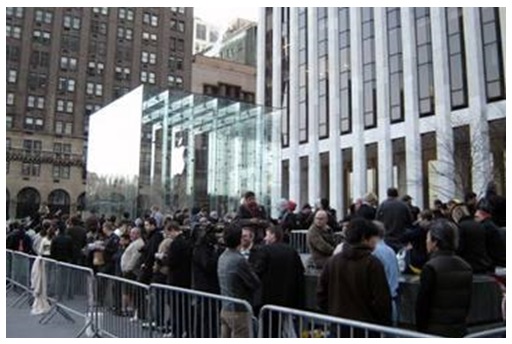
Research Questions
My name is………… from… University. I am conducting a survey for my degree programme. Please kindly spare me a few minutes of your time to fill this survey questionnaire.
Background information
Age:
- 18 -24 year [ ]
- 25 years and above [ ]
Gender:
- Male [ ]
- Female [ ]
Occupation: Student [ ]
- Do you own any Apple product?
- Yes [ ]
- No [ ]
- How many Apple products do you own?
- …….
- How long have you used Apple products?
- ……. years
- Do you have other products from Apple competitors?
- Yes [ ]
- No [ ]
- If yes in the above question, please mention the brand ………………. ………………. ………………. ……………….
- Do features of Apple products influence purchasing behavior among students in the UK?
- Yes [ ]
- No [ ]
- Which brand do you plan to purchase in the future?
- ………………. ………………. ………………. ……………….
- Which Apple product features influence your purchase decision?
- ………………. ………………. ………………. ……………….
- Do you consider value-added features for students in purchasing decision?
- Yes [ ]
- No [ ]
- Which student features and other features influenced your purchase decision?
- ………………. ………………. ………………. ……………….
- Are you obsessed with Apple brand?
- Yes [ ]
- No [ ]
- Please, explain how you consider the product in your life e.g., lifestyle, freedom, devotion etc ………………. ………………. ………………. ……………….
- Choose a factor that influence your choice of Apple technology product:
- Price [ ]
- Brand [ ]
- Technical features [ ]
- Interconnectivity [ ]
- Size and design [ ]
- Rate your consumer experience with Apple products
- Mark in the box by using a scale of 1 to 3 in which 1 = very satisfied 2 = satisfied 3 = not satisfied
Any other comment ………………. ………………. ………………. ……………….
Thank the respondent and close the interview!